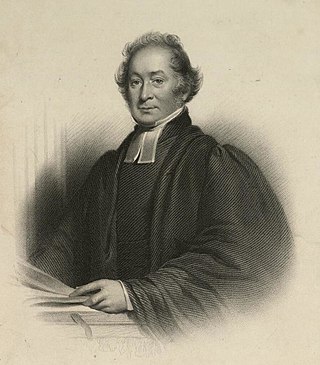
Hanover Chapel was a church in Regent Street, London. It was built in 1825, and was demolished in 1896.

Hanover Chapel was a church in Regent Street, London. It was built in 1825, and was demolished in 1896.
The building was situated in Regent Street between Hanover Street and Prince's Street. [1] It was designed by Charles Robert Cockerell; the first stone was laid on 6 June 1823, and it was completed in 1825. [2]
William Carnaby was organist from its opening until his death in 1839; [3] in that year Charles Lucas was appointed organist. [4] The incumbent was for many years the Reverend Joseph George Brett (father of William Brett, 1st Viscount Esher). [5]
Edward Walford wrote in 1878: "... it is of the Ionic order, and in its internal arrangement somewhat resembles St Stephen's Church, Walbrook. The altar is enriched with carved work, and the fabric generally forms a fine architectural display, though utterly unsuited to a church." [1]
The chapel was demolished in 1896, and Regent House ( a Grade II listed building, at grid reference TQ 29024 81120 , coordinates 51°30′51.4″N0°8′31.2″W / 51.514278°N 0.142000°W [6] ) was built on the site. There is a plaque attached to the building on the left of the original entrance door, informing that Hanover Chapel formerly stood on the site. Regent House now contains the London Apple Store. [7]

Thomas Phillips was a leading English portrait and subject painter. He painted many of the great men of the day including scientists, artists, writers, poets and explorers.

St Peter, Vere Street, known until 1832 as the Oxford Chapel after its founder Edward Harley, 2nd Earl of Oxford and Earl Mortimer, is a former Anglican church off Oxford Street, London. It has sometimes been referred to as the Marybone Chapel or Marylebone Chapel.
John James Bond was an English chronologist, who served in the record office of Queen Victoria.

The Octagon Chapel, Liverpool, was a nonconformist church in Liverpool, England, opened in 1763. It was founded by local congregations, those of Benn's Garden and Kaye Street chapels. The aim was to use a non-sectarian liturgy; Thomas Bentley was a major figure in founding the chapel, and had a hand in the liturgy.

Bartholomew Lloyd was an Irish mathematician and academic who served as the 27th Provost of Trinity College Dublin from 1731 to 1737. His entire career was spent at Trinity College Dublin. As Erasmus Smith's Professor of Mathematics there, he promoted significant curricular reforms, including the introduction of the teaching of calculus.

Thomas Raffles was an English Congregational minister, known as a dominant nonconformist figure at the Great George Street Congregational Church in Liverpool, and as an abolitionist and historian.

Robert Walpole (1781–1856) was an English classical scholar.
The Reverend Frederick Scotson Clark was an English organist and composer. He was founder of the London Organ School and College of Music.
Edward Tagart was an English Unitarian divine.
John Feltham Danneley was an English writer on music.

James Heseltine was organist of Durham Cathedral.
Charles Knyvett was an English singer and organist. He established in 1791 in London the Vocal Concerts, a series of subscription concerts.
William Carnaby was an English organist and composer.
George Jackson Lambert was an English organist and composer, for many years organist of Beverley Minster.
Joseph John Harris was an English organist and composer, from 1848 organist of Manchester Cathedral.
Trinity Chapel was a proprietary chapel in Conduit Street, London. It opened in 1691, and was demolished in 1875.
St Peter's Church was an Anglican church in Regent Square in the London Borough of Camden. It was built in 1826, and was demolished after being badly damaged in World War II.
St Luke's Church was an Anglican church in Berwick Street, in the City of Westminster, London. It was built in 1839, on the site of a Huguenot church of 1689 and an Anglican chapel of ease of the 18th century. It was demolished in 1936.